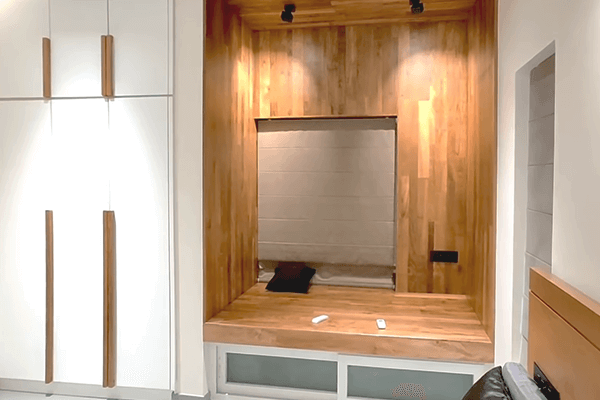There’s no doubt that exciting times lay ahead in the field of architecture, particularly with the concept of the metaverse threatening to make physical barriers a thing of the past.
However, this trend is likely to evolve slowly and over a concerted period of time, while there are far more pressing developments influencing architecture in 2022.
We’ve outlined some of these below, while asking how they’re likely to impact homes and the architectural landscape of the UK.

Contents
6 Modern Architectural Trends You NEED to Know About
1. The Rise of Smart Homes
The concept of so-called “smart” homes is nothing new, with this technology having evolved over the course of the last decade and at least 57% of Brits now boasting at least one smart product in their interior.
However, smart technology is becoming increasing pronounced and influential in the modern home, while products are also being integrated into new build projects nationwide.
As a result, homes are becoming increasingly connected and sophisticated in terms of how they manage things like energy consumption, while also impacting how homes are designed and built in the first place.
2. Entering an Age of Reset or ‘DIY’ Architecture
We’re also seeing a growing number of architectural projects carried out by home or landowners themselves, with this process referred to as either ‘DIY’ or ‘reset’ architecture.
The reasons for this are obvious; as such projects allow home or landowners to work independently and engage in stripped-back constructions that are considerably cheaper (especially from a labour perspective).
Of course, to design and build your own home you’ll need at least some basic knowledge or skills (or a least a willingness to learn), while having access to specialist tools such as Milwaukee drill drivers is also extremely beneficial.
Similarly, take time to identify the best materials for your particular project, while recognising that this can take much longer to complete than traditional builds.
3. 3D-Printed Architecture is Here to Stay
3D printing is increasingly dominant in a diverse range of sectors, and architecture is absolutely no exception to this rule.
Certainly, contemporary architects now prefer to use 3D printing technology to help conceive and build structures, thanks largely to its deceptive simplicity, ease-of-use and incredibly innovative nature.
It’s also highly efficient, creating construction processes that incur fewer errors and enable architects to spend much less time working on individual projects.
Above all else, the barriers involved in 3D printing are virtually non-existent, meaning that the possibilities are limitless when creating new designs and bringing these to life!
4. The Continuation of Sustainable Architecture
We close with perhaps the biggest architectural trend, with sustainable buildings and construction processes increasingly popular across the globe.
This trend has evolved in line with our own growing awareness of environmental issues and sustainability, as architectures are now looking to create new homes that interact seamlessly with the natural environment.
The key point here is that sustainable architecture will evolve to benefit the natural environment rather than take from it, which is something that could be advantageous to us all over time.
5. Minimalistic Architecture
It’s a trend that has been around for a while, but it’s still making waves. Minimalist architecture was first coined in the 1960s by architect Ludwig Mies van der Rohe. The term came from his concept of “the truth in architecture,” which he believed to be the “simplest” way to create an appealing space.
Mies’s minimalist ideas have been adopted by many contemporary architects, and they’ve had some great success with them. In fact, minimalism is so popular now that it’s getting its own category at auction houses like Sotheby’s and Christie’s.
As the world becomes more and more connected, we are becoming more aware of the effects of space on our daily lives. The idea that minimalism can have a positive impact on our relationship with the world around us is one that everyone should be familiar with.
Minimalistic architecture is on the rise, with new buildings popping up all over the world. The trend began in California as a reaction to modernism and its emphasis on minimalism, but it has now spread to other parts of the United States, as well as Europe and Asia.
The goal of minimalist architecture is not only to make people feel less stressed and more at ease while they’re working or living in their homes. But also to create spaces that are easy on the eyes and easy on the mind. People who live in these types of homes tend to have less anxiety about their surroundings because they know exactly what went into creating them.
People also tend to feel more productive since there’s less visual noise in their surroundings than there would be if they were surrounded by tons of stuff.
In short: Minimalism makes people feel better about themselves and their surroundings.
6. Tiny Houses
Tiny houses are quickly becoming a trend, and for good reason: they’re a lot of fun to design, build, and live in. But there’s more to tiny architecture than meets the eye. Tiny houses are often thought of as a way to save money and energy. But they are also an incredibly environmentally friendly way to live.
With so many benefits, you might be wondering why anyone would want to live in a bigger space than they need. The answer is simple: Tiny houses can offer you so much more than your typical home! You’ll be able to save money on utilities by not having a big heat or air conditioning unit running 24 hours a day. And maybe even catch a break on your monthly rent if you don’t have any roommates or kids running around.
You’ll be able to put off buying that car until later when gas prices go down again. Or maybe never buy one at all.
And don’t worry; you won’t feel like you’re living in a cage while you’re enjoying all these perks! There are plenty of tiny homes designed with comfort in mind, making them feel like home right away without sacrificing any functionality or style.
Conclusion
Trends in the architecture are changing and people are becoming more inclined toward minimalism and tiny houses. We hope you find this post interesting and built something around these trends for your comfort.
